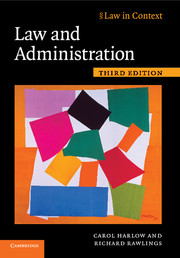Book contents
- Frontmatter
- Contents
- Preface
- Table of Cases
- Table of Statutes
- 1 Red and green light theories
- 2 The changing state
- 3 Transforming judicial review
- 4 Making the law
- 5 Rules and discretion
- 6 Regulation and governance
- 7 Regulatory design and accountability
- 8 Contractual revolution
- 9 Contract, contract, contract
- 10 Into the jungle: Complaints, grievances and disputes
- 11 Tribunals in transition
- 12 The Parliamentary Ombudsman: Firefighter or fire-watcher?
- 13 Inquiries: A costly placebo?
- 14 Continuity and change: Procedural review
- 15 Elite dimension: Court structures and process
- 16 Judicial review and administration: A tangled web
- 17 ‘Golden handshakes’: Liability and compensation
- Index
17 - ‘Golden handshakes’: Liability and compensation
Published online by Cambridge University Press: 05 June 2012
- Frontmatter
- Contents
- Preface
- Table of Cases
- Table of Statutes
- 1 Red and green light theories
- 2 The changing state
- 3 Transforming judicial review
- 4 Making the law
- 5 Rules and discretion
- 6 Regulation and governance
- 7 Regulatory design and accountability
- 8 Contractual revolution
- 9 Contract, contract, contract
- 10 Into the jungle: Complaints, grievances and disputes
- 11 Tribunals in transition
- 12 The Parliamentary Ombudsman: Firefighter or fire-watcher?
- 13 Inquiries: A costly placebo?
- 14 Continuity and change: Procedural review
- 15 Elite dimension: Court structures and process
- 16 Judicial review and administration: A tangled web
- 17 ‘Golden handshakes’: Liability and compensation
- Index
Summary
Liability or compensation?
In the last three chapters we have looked in some detail at judicial review, today the principal machinery through which courts exercise their function of controlling the executive and for many — especially red light theorists — the centrepiece of administrative law. Judicial review is not the only mechanism for the challenge of executive and administrative action; as we have seen, human rights claims may be raised in every form of judicial process, including criminal proceedings. Judicial review procedure is also subject to the substantial limitation that compensation, in practice sometimes the only suitable remedy, is not usually available. The reformed modern judicial review procedure (see Chapter 15) allows the Administrative Court to award damages on an application for judicial review but only when ‘the court is satisfied that, if the claim had been made in an action begun by the applicant at the time of making his application, he would have been awarded damages’ (s. 31(4) (b) of the Supreme Court 1981). This has the effect of linking damages to the existing law of tort. It has to be said that the writ procedures of the High Court, with detailed pleadings and oral evidence, are in practice better suited for fact-finding in damages actions; these are therefore routinely transferred out of the Administrative Court after the court has determined the public law issues. Cases where a claim for damages is joined to a judicial review application are, however, rare and cases where compensation is actually ordered even rarer.
- Type
- Chapter
- Information
- Law and Administration , pp. 749 - 794Publisher: Cambridge University PressPrint publication year: 2009



